| Pages:
1
..
18
19
20
21
22
..
25 |
DosMars
Nomad
 
Posts: 118
Registered: 12-11-2005
Member Is Offline
|
|
Been waiting all day for this installment, definitely worth the wait! Looking forward to pics...
|
|
|
larryC
Super Nomad
   
Posts: 1499
Registered: 8-11-2008
Location: BoLA
Member Is Offline
|
|
Those pink mountains are some of the prettiest scenes I have ever seen. I'll never forget them. Looks like you noticed also that most of the palms
have burned in the past, but have survived. I'm guessing it is mother natures way of cleaning out the forest. I am curious about the abandoned camp. I
heard from a kayaker that he had ventured up the canyon and come across some guys with guns growing pot. I took the story with a grain of salt. Maybe
there is some truth to the story. The quad tracks could be from the 2010 trip but there were at least 3 quads on that trip. Another mystery. Maybe the
pot growers had a quad.
Glad you made it happen.
Larry
Off grid, 12-190 watt evergreen solar panels on solar trackers, 2-3648 stacked Outback inverters, 610ah LiFePo4 48v battery bank, FM 60 and MX60
Outback charge controllers, X-240 Outback transformer for 240v from inverters, 6500 watt Kubota diesel generator.
|
|
|
Mark_BC
Nomad
 
Posts: 137
Registered: 12-1-2013
Location: Vancouver, BC
Member Is Offline
|
|
Yeah that camp was a mystery. I doubt it was for pot, I don't know where you'd grow them.
Part 8 - Out to Salsipuedes Beach
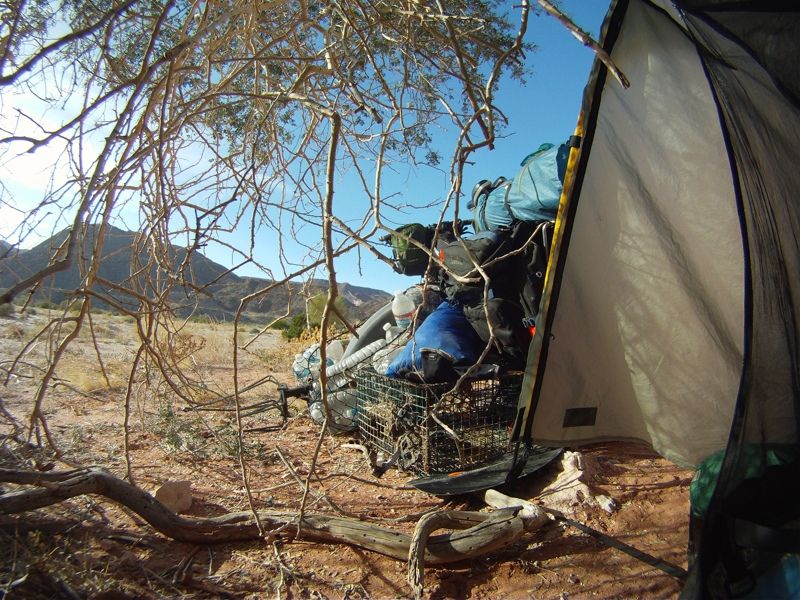
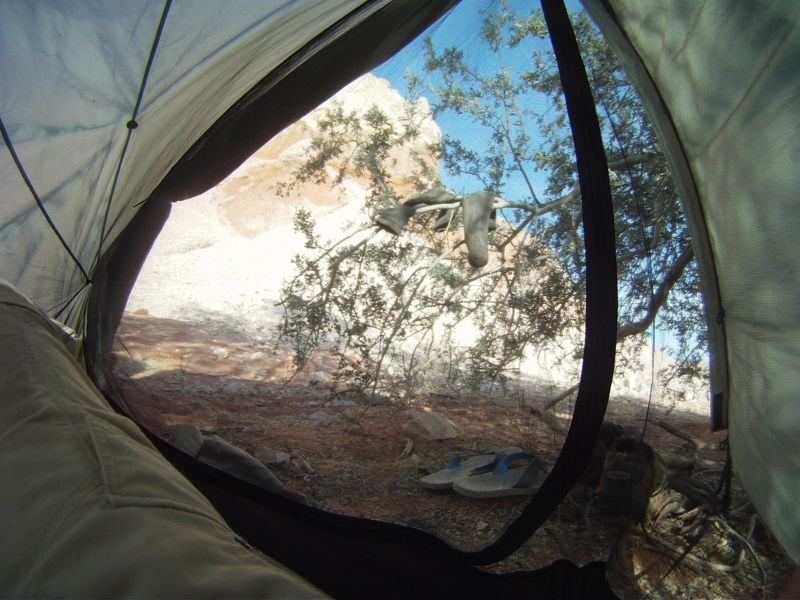
I woke up to a totally flat front tire. No matter what I did or how I tilted it, it wouldn't stop hissing. I was so intent on listening for faint
hisses that I think I started imagining them in the silence of the desert.
So I had to take the wheel apart. Luckily this wasn't the back wheel as that one is a bit trickier to take it off. My poor front tire, it takes all
the abuse.
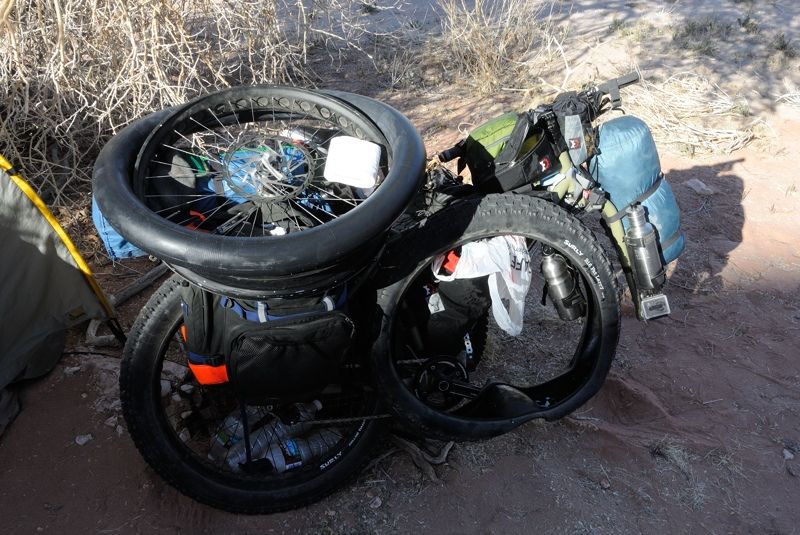
I soon discovered the source of the problem -- a few inch long spines sticking through the tire and innertube. I think the self sealing goop works
best with a tubeless tire. If there is a tube then the spines constantly jiggle between the differential movement of the tire and tube and never
fully seal. The agave puncture sealed up well because the spines came out when I pulled the bike away. Cactus spines have barbs and are hard to pull
out.
But going tubeless is a skill I haven't learned yet. I don't know how to seat the tire bead so that the tire seals up against the rim so I can
actually start pumping. For now the tire just kind of hangs there until the inflating innertube pushes it out against the rim.

So I had a bit of a late start that morning. I pushed the bike back to the wash, being careful to avoid the spike balls. I continued on down the wash,
taking videos as I went. There were lots more of the pink hills, but nothing quite so dramatic.
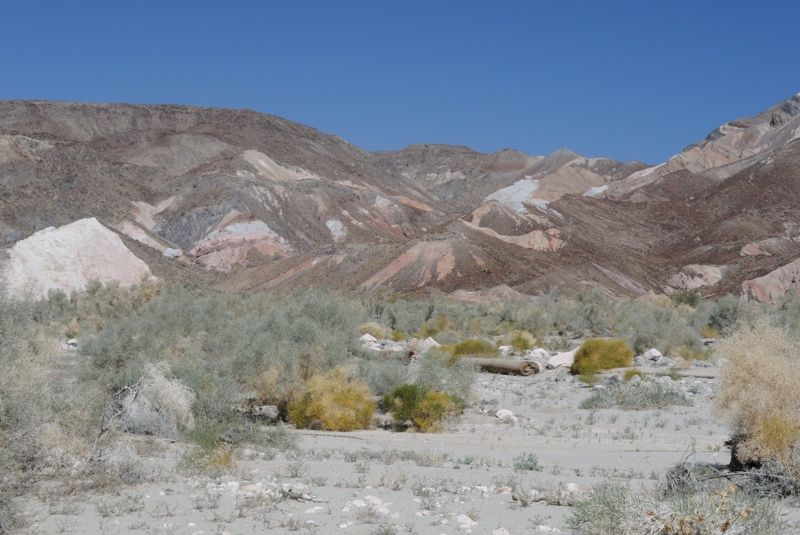
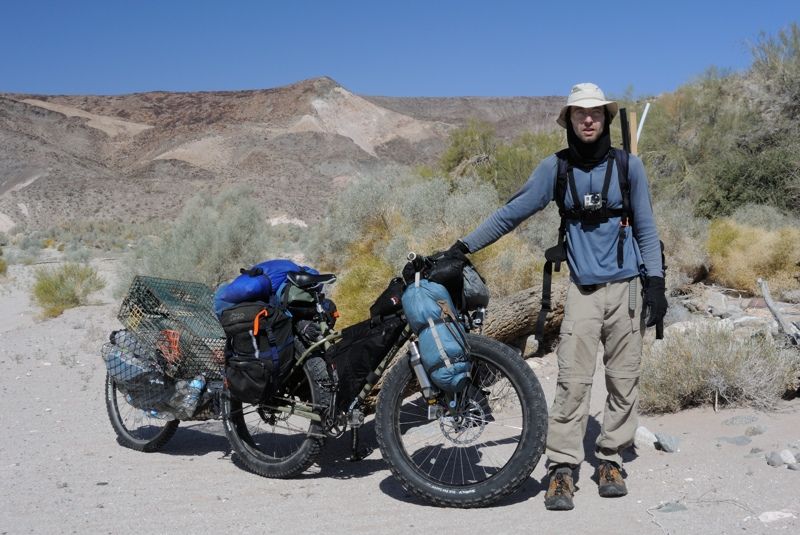
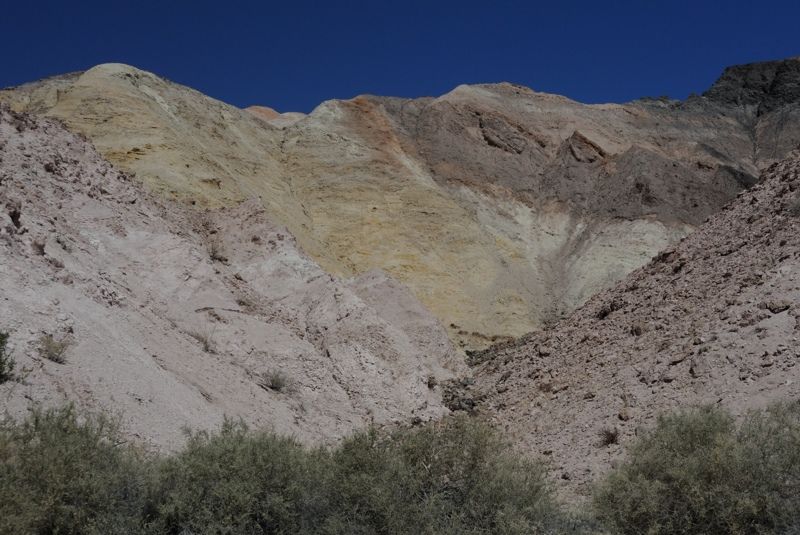
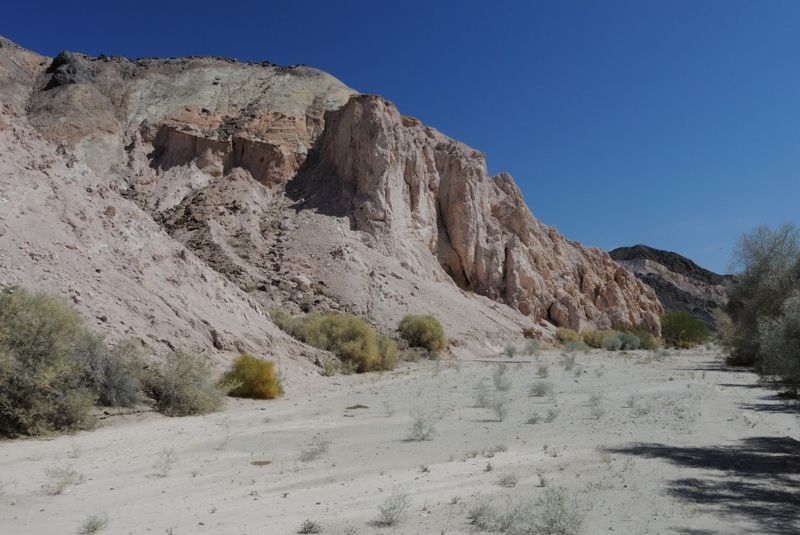
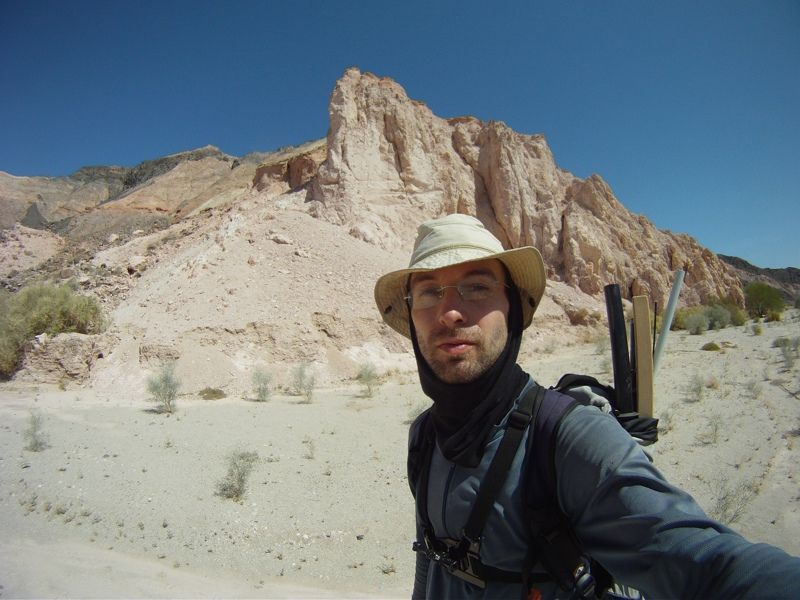
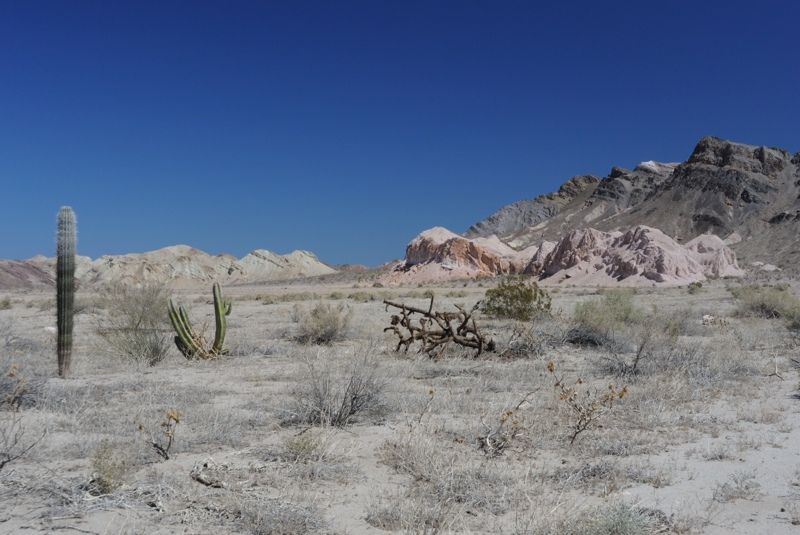


And there was a whole bunch more of the spike balls too. Even though the lower wash is very wide, the most recent flow route was pretty narrow and
offered the cleanest sand to ride. But it could be convoluted and went over rocks in places. This provided plenty of opportunity for spike balls to
lurk. Sometimes I'd go through whole beds of them and would immediately stop to pull them all out. I was worried about the trailer tire since I was
swerving so much and it wasn't following the tracks of the bike tires.
But I made my way down slowly and surely and was anticipating what the first glimpses of the ocean would be like. Then all of a sudden, there it was!
A sliver of blue way down there.
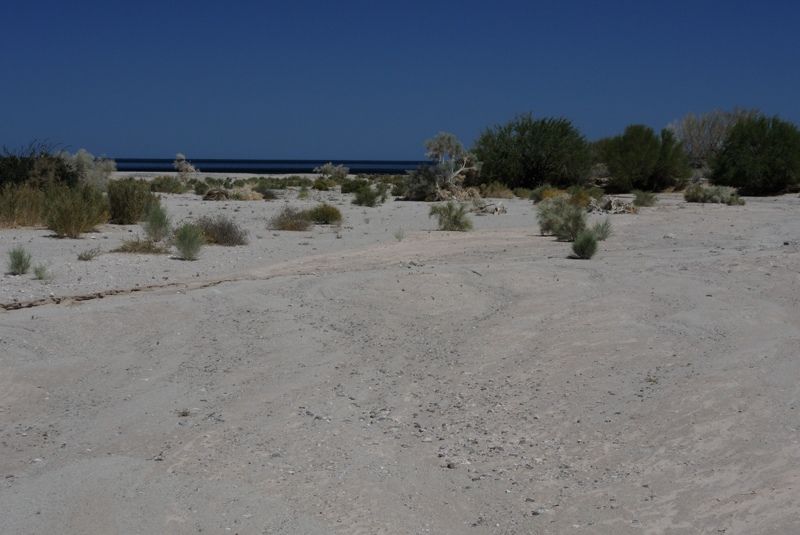
It was still a couple km away but eventually I got there, scaring some rabbits up along the way. Finally I made it! It felt so good.
It was early afternoon and hot, with no shade. There isn't much to say about how the Salsipuedes meets the sea. It is a big rocky beach with some sand
and dried mud above the high tide line, and wood and other flotsam and garbage blown up into the higher ground. There are also palm trunks around too.
There was a slight northern wind. I scrounged around to see what I could find that was useful -- a lid-less white cooler which could be used to store
things away from the rocky beach and keep them cool, various crates, a wooden palette, a plastic spoon, and a fully functional pfd.
I decided that I had to move to either the northern or southern headland. The northern one offered a sunshade that someone had put up.
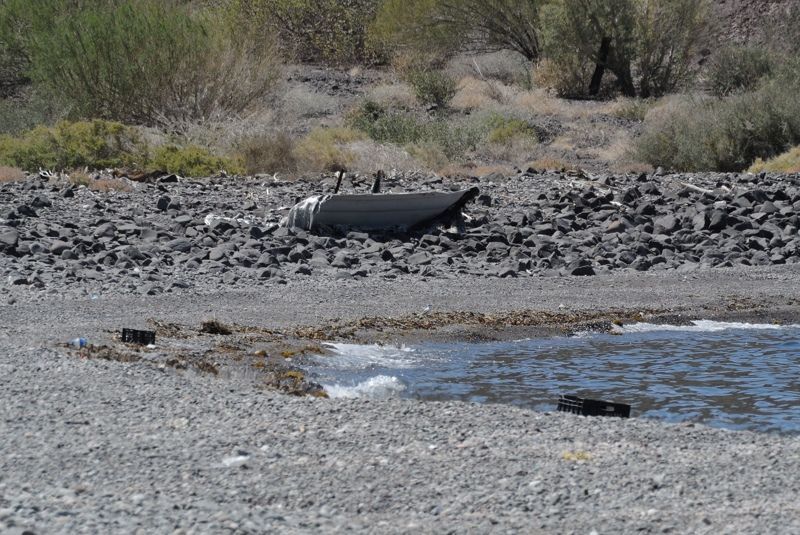
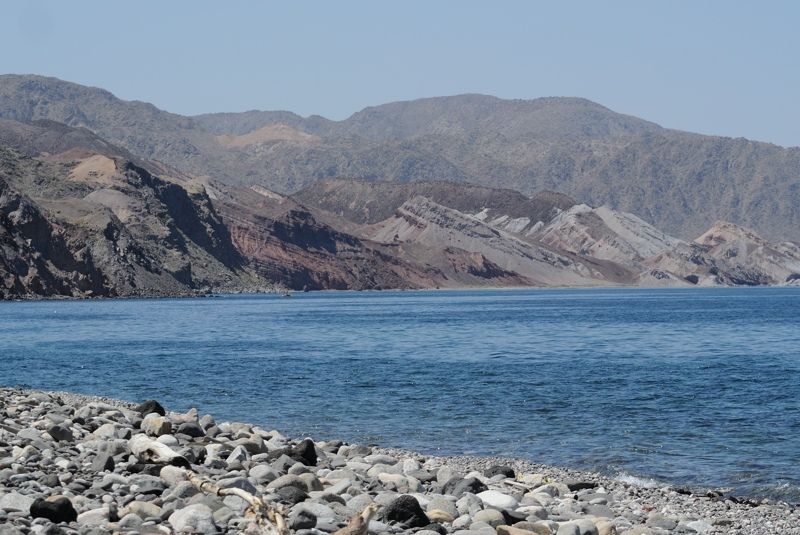
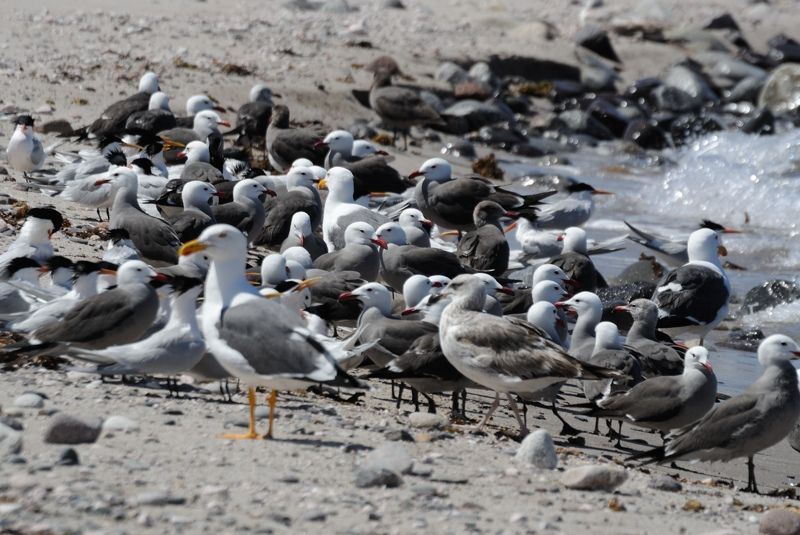
And Mark wanted me to go check out the little reefs just offshore a few km north. But I think that would be asking too much given the northern winds
and how hard it was to get by day to day. I was heading south, so I went south. But Mark points out that it should be possible to ride up to those
little reefs via an overland trek a couple miles up the wash, then descend the next little wash heading north. From GE it looks do-able. And I have to
admit that there are some pink hills up there that looked intriguing as I went down the wash. I briefly contemplated a short exploration up there as I
rode by.
I had already unpacked half my gear on the beach so I decided to put back what I could on the bike and take the rest, along with my newly discovered
treasures, down in my packraft. I'd push the bike along the rocky beach to the next point which allowed me to keep an eye on it from both sides in
case the ravens or coyotes went to town on it. Then I'd go back to retrieve the packraft and paddle down to the southern headland.

This worked out ok, and the winds were behind me. I had the lobster trap and a crate on the front of the raft, and my fishing rod ready for trolling.
But then as I was paddling south I saw a big bird commotion a little further down, about a half km offshore.

That meant the predatory fish like barracuda or yellowtail were pushing a ball of little fish to the surface. Great, boils never let me down! So I
raced over and got out the rod. I tried to cast with my gloves on and the thing totally jammed! And the barracuda were swimming 3 feet under my boat!
I cannot describe how frustrating that was. The issue was that it was a very small reel, for carrying on my bike, and I loaded it with too much line.
I managed to get some line out and I hooked one! I pulled it up out of the water and it was a nice foot long barracuda, just like I had been dreaming
about! But then I realized I was a ways offshore in an inflatable boat with a sharp-toothed barracuda flapping around on the line. And I had turned
into the wind and the upper crate had blown over on its side. If I had lashed it more securely it would have been the perfect place to put the fish.
So I mucked around a little bit to prepare for the landing and the thing got off the hook! I had earlier on broken off the barbs for the fishes' sake
but I was cursing that decision! Screw the fish, I wouldn't be releasing anything I caught out here.
I can't tell you how much I wanted that fish. I would have taken a bird too / instead if one had grabbed the lure. Maybe not a pelican but a gull for
sure. Hell, maybe even a pelican.
I got one more bite but it got off the hook before getting to the boat and that was it ... no more fish! Party over, everyone go home. I was soooo
disappointed. I limped back to shore and instead cooked up the can of spicy tomato paste I stole from camp, along with some spaghetti pasta I brought,
as that packs the densest and offers some extra bulk and calories to my freeze dried backpacker food packets. It was actually pretty good but I would
so much rather have been eating barracuda!
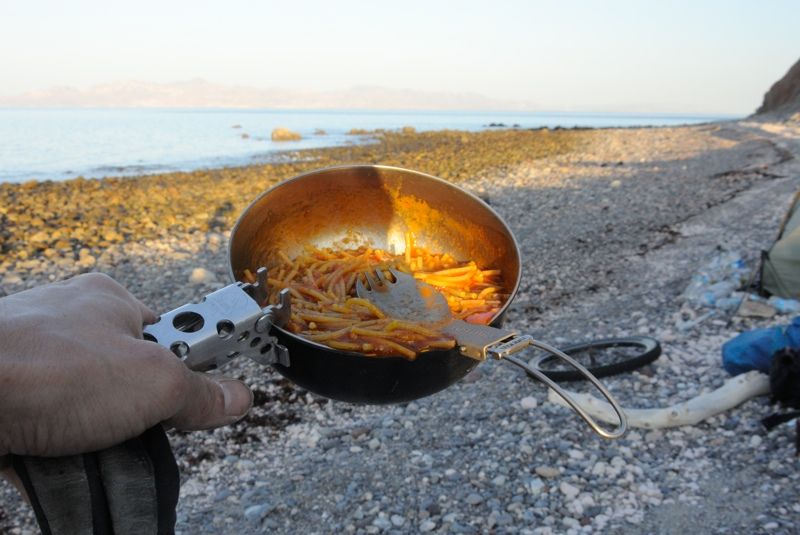
I arrived on the beach at high tide and by evening it had gone out. Holy cow are the tides ever huge here! Probably close to 20 feet, and it went out
like 50 meters. They resonate and amplify up and down the Gulf of California., like in the Bay of Fundy in Nova Scotia.


I went to bed and hoped for another bird boil the next day. I'd try my various seawater desalination techniques too and assess that critical aspect of
my survival while I still had a few days of water left. At least on the beach I wouldn't be burning through the water so fast since I wouldn't be
working hard.
The next day brought some morning southern breezes that shifted to northern by midday. That should work out ok for packrafting south if it keeps up.
I tried my desalinating hand pump and discovered that it was a lot of work! It produces about a liter an hour but that requires constant hard pumping.
You can't do anything else. Pretty tedious. And in order to prolong the membrane's life I was pre-filtering the seawater with my backpacking filter.
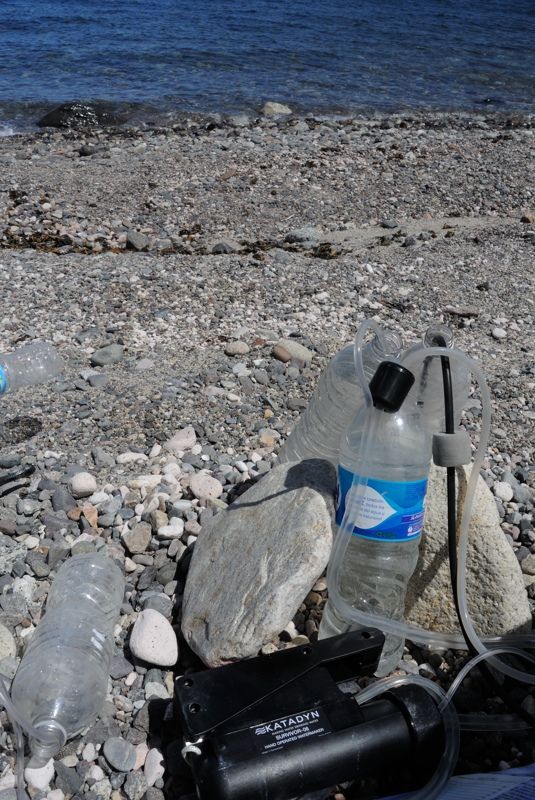
I also tried my campfire seawater distilling pot. This worked better than expected. I got about a half liter in an hour on the fire. So making fresh
water would be possible, but not easy. I had 8 liters or so, enough for over 2 days, so no rush.
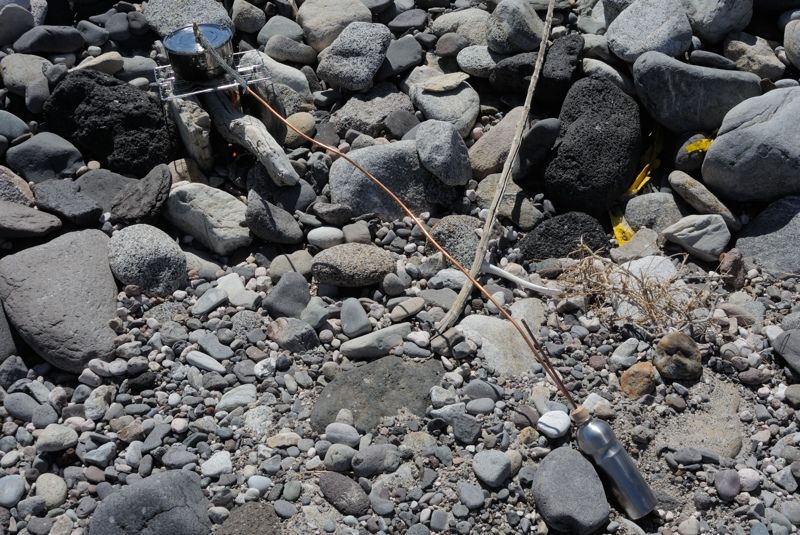

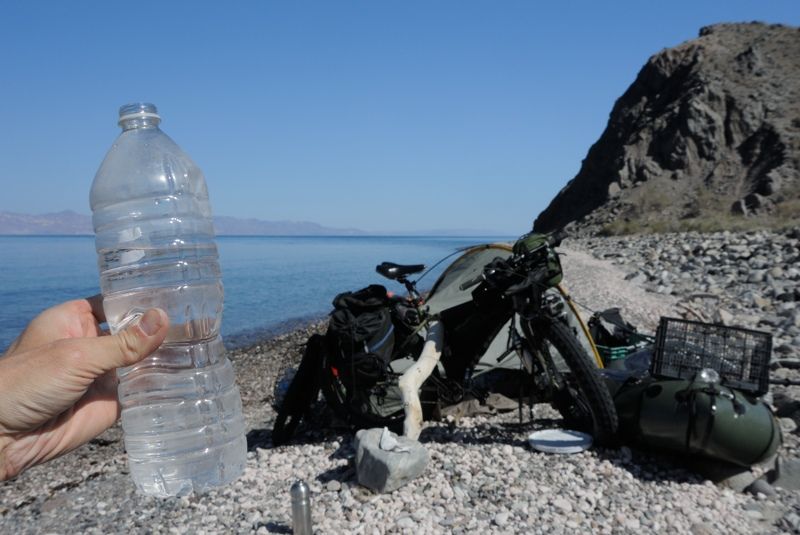
I also did a food inventory -- enough for about 8 days, assuming I caught no fish. But that morning I was very hungry and had oatmeal as well as honey
stingers lathered with peanut butter. It seems my appetite was catching up with my calorie expenditures... It takes a few days. So maybe I didn't
have 8 days of food left.
At one point in the day a coyote just brazenly walked out on the beach 50 feet from me and then went back into the desert by my camp. It showed no
fear. Maybe I was the first person it had seen. Because of all the coyotes and birds that seemed ready and willing to pilfer my camp, I was hesitant
to go out fishing in my packraft. This is the same issue I encountered kayaking up BC's Inside Passage; if I left my stuff on the beach it would be
easy pickings for a bear or other animal. In this respect and others, it would be better to go with other people so duties can be divided up. And the
video and pictures would be much better too. But it makes for a better story going it alone.
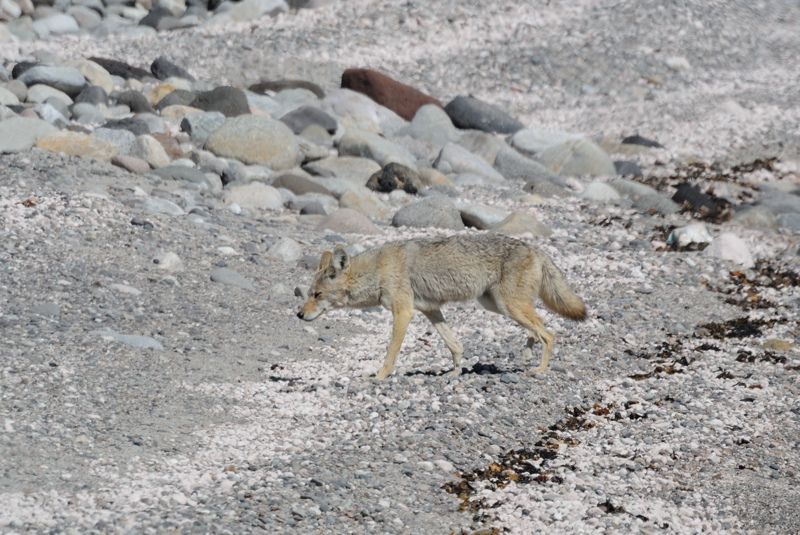
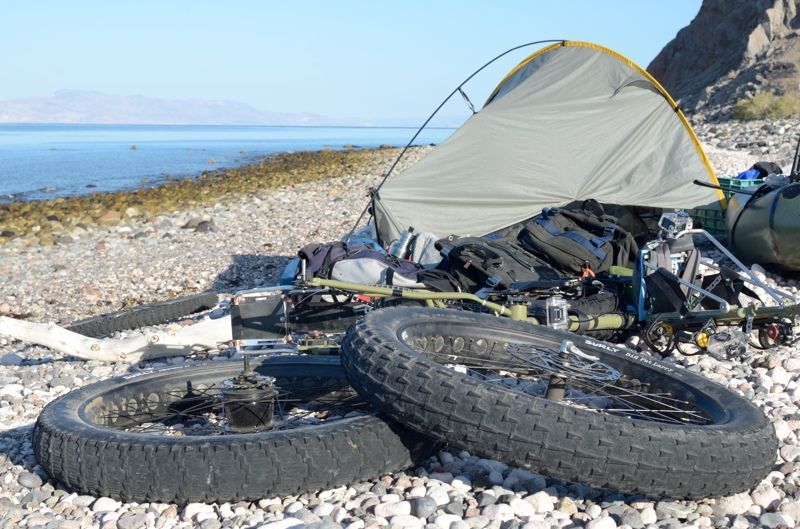
I had my packraft and fishing gear ready to go in case of a bird boil but there was no activity that day and the rocky beach seemed pretty desolate
fish-wise, so I decided to head south the next morning if the winds were favorable. It was nice to be back at the ocean with all the life to keep me
company. The sea lions were rafting just off the beach, and I even heard some whales offshore.
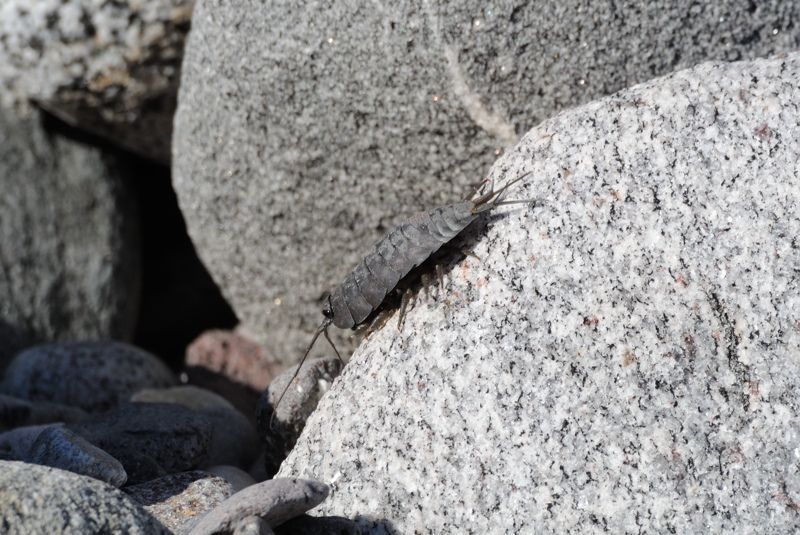
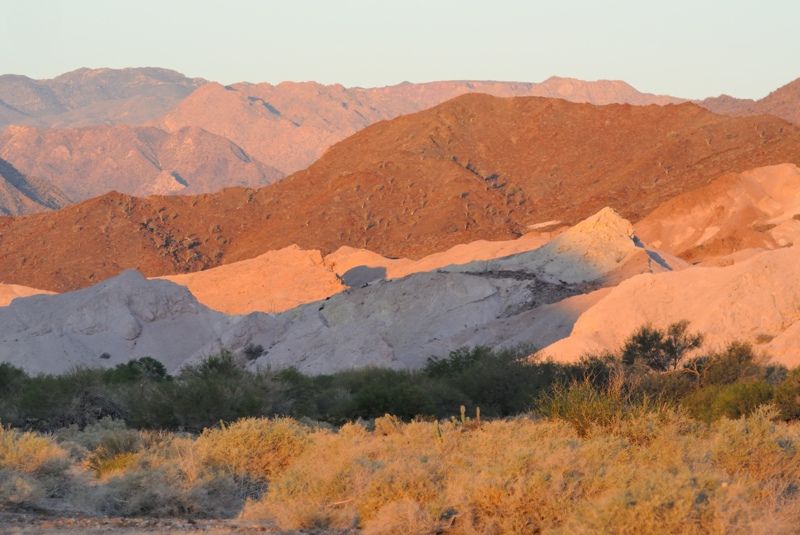
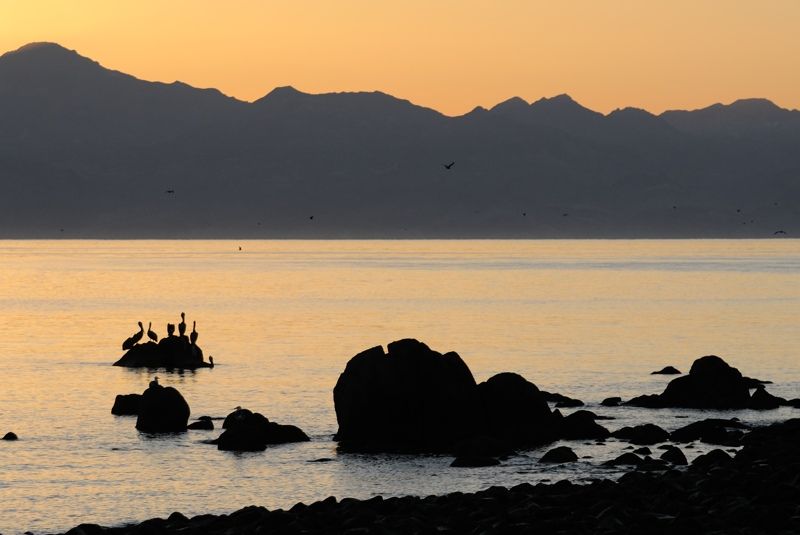
[Edited on 6-22-2014 by Mark_BC]
[Edited on 7-7-2014 by Mark_BC]
|
|
|
TMW
Select Nomad
      
Posts: 10659
Registered: 9-1-2003
Location: Bakersfield, CA
Member Is Offline
|
|
Have you looked into using a foam tube insert instead of a tube. They make them for bicycles and off road motorcycle tires. I have them in my bicycle,
no more flats. As to the ride my bike feels like I shifted about two gears higher as there is more resistance. I've ran moose tubes in a motorcycle
and they feel a little harder. Here is a web site of one company, maybe talk to them and see if something is available for your bike.
http://www.brapoffroad.com/accessories/tech-tube-foam-insert...
|
|
|
Skipjack Joe
Elite Nomad
     
Posts: 8088
Registered: 7-12-2004
Location: Bahia Asuncion
Member Is Offline
|
|
| Quote: | Originally posted by Mark_BC
I woke up to a totally flat front tire. No matter what I did or how I tilted it, it wouldn't stop hissing.
|
Sounds like my ex-wife.
|
|
|
DosMars
Nomad
 
Posts: 118
Registered: 12-11-2005
Member Is Offline
|
|
Good stuff Mark! Did you try any of the circle hooks I gave you? Turn over a couple of rocks for a few snails, crush up the shell & use for
bait.
Easy-peasy fresh & easy seafood dinner...
Grab some limes and head out to La Gringa for a night or two -relax & practice your fishing skills!
[Edited on 4-9-2014 by DosMars]
|
|
|
JohnMcfrog
Nomad
 
Posts: 156
Registered: 8-1-2012
Location: San Diego, Punta Abreojos
Member Is Offline
|
|
I mountain bike at least once a week. In the closest mountains, there are not too many goat heads or cactus spines. Regular tubes work, so haven't
really kept up with the technology.
Of the guys who ride with me are a group of moto guys, formerly competitive. All of them are riding tubeless, with Stan's rimtape and Stan's sealant.
You tube on install:
https://www.youtube.com/watch?v=9RzASr-cPPs
All of these ex-moto guys have said no more goat head and cactus problems.. I plan to use them in Abreojos because of the goat heads.
|
|
|
mtgoat666
Platinum Nomad
       
Posts: 20217
Registered: 9-16-2006
Location: San Diego
Member Is Offline
Mood: Hot n spicy
|
|
i would like to see a pic of the raft... curious what raft is light enough to carry on bike, but large enough to carry bike and gear and person...
|
|
|
DosMars
Nomad
 
Posts: 118
Registered: 12-11-2005
Member Is Offline
|
|
Thanks for the video link John. Looks easy enough, I'm going to try tubeless on the fat-tire I bought off of Mark after his last trip up the canyon.
He left me with a never ending flat rear tire with all of the thorns he picked up!
|
|
|
DosMars
Nomad
 
Posts: 118
Registered: 12-11-2005
Member Is Offline
|
|
| Quote: | Originally posted by mtgoat666
i would like to see a pic of the raft... curious what raft is light enough to carry on bike, but large enough to carry bike and gear and person...
|
I think there's a link to a video a page or so ago. Very impressive little inflate able kayak type raft designed to get you in & out of the
outback up north...
|
|
|
Barry A.
Select Nomad
      
Posts: 10007
Registered: 11-30-2003
Location: Redding, Northern CA
Member Is Offline
Mood: optimistic
|
|
Hopefully "Part 9" is soon to be posted. I love reading and thinking about this great adventure, and the writer is great----love all the detail,
truly!!!
Barry (Bump--- to keep this thread current---- (-: )
|
|
|
DosMars
Nomad
 
Posts: 118
Registered: 12-11-2005
Member Is Offline
|
|
Part 9 is in the can, I've got mark emailing these to me ahead of posting here so I can get a sneak peak of what's coming up... :-)
It'll be up soon!
|
|
|
DosMars
Nomad
 
Posts: 118
Registered: 12-11-2005
Member Is Offline
|
|
Here's a teaser...
Part 9 - Packrafting the Coast to Candelero
The next morning the winds were dead. I had prepared a lot of my stuff for the boat ride the day before but I still had a bunch to do in the morning.
I got up early because I wanted to make it all the way to Candelero, 12 km to the south. But I would have to launch in sync with the tide...
|
|
|
Mark_BC
Nomad
 
Posts: 137
Registered: 12-1-2013
Location: Vancouver, BC
Member Is Offline
|
|
Can't access my emails for some reason. Sent you a u2u Mark.
Part 9 - Packrafting the Coast to Candelero
The next morning the winds were dead. I had prepared a lot of my stuff for the boat ride the day before but I still had a bunch to do in the morning.
I got up early because I wanted to make it all the way to Candelero, 12 km to the south. But I would have to launch in sync with the tide.
I filled my packraft pontoons with most of my stuff, minus my backpack, bike, trailer, full water bottles, and other various items I'd be needing on
deck over the day. It all went in. I videotaped the transformation but unfortunately the memory card ran out after the first item went in! I'll have
to redo that scene. The last items to go in were my two bike panniers, which just barely fit. Then I zipped it up and finished inflating it.
I carried it down to the rocks to where I thought the tide would be a half hour later. That would give me time to lash the bike and everything else on
the front. Unfortunately the lobster trap wasn't coming... no space. I got it all in and then waited for the tide to float it. It eventually did of
course and I managed to push my way through the remaining rocks out to oceanic freedom.
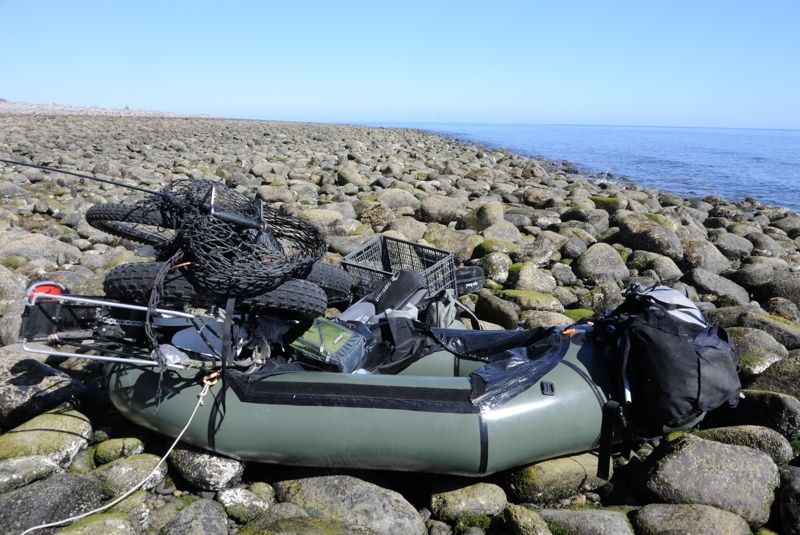
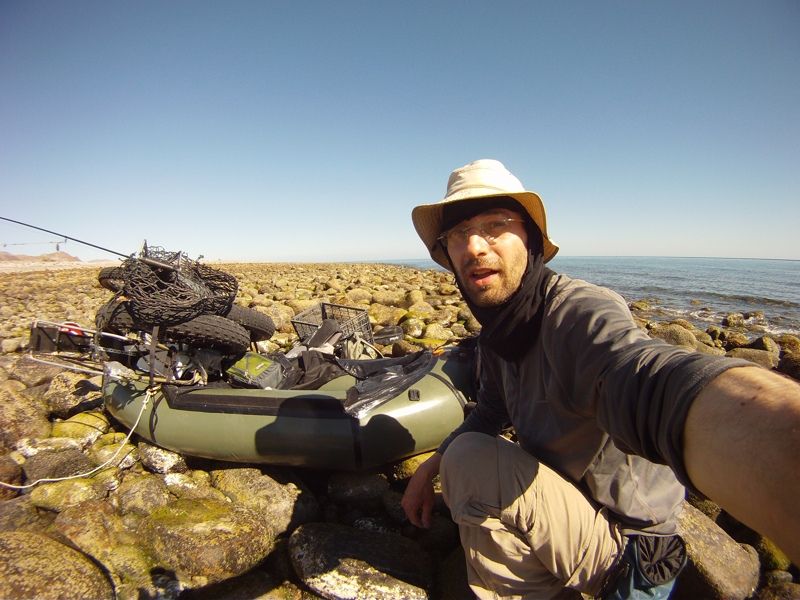
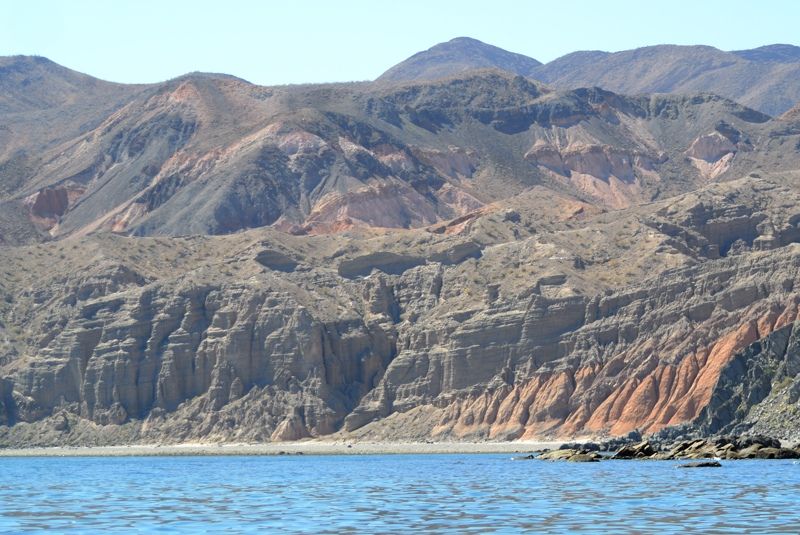
I soon noticed that the weight distribution on water was not the same as on land. The front bicycle fork was dragging in the water and the disc brake
was completely submerged. This also affected the boat's tracking. Not good! But there was nothing I could do about it now. I had taped pieces of
plastic over all the other sensitive components to protect from splashes but that wouldn't help with full submergence! And I strapped my backpack to
the back of the boat but the looseness in the strapping allowed it to slide down to touch the water. I'll have to add a couple more grab patches
further forward to cinch it up.
I slowly plodded my way south. I was a few hundred meters offshore and noticed that I was going slower relative to the shore than to the water, so I
was fighting the current, which made sense in a rising tide. So I went in and hugged the shoreline. A fishing boat came by and waved hello. They
probably thought I was crazy. It turns out you could probably push your bike about 3 km south along the rock beach down to that big beach that faces
northeast. After that it would be impassable by shore.

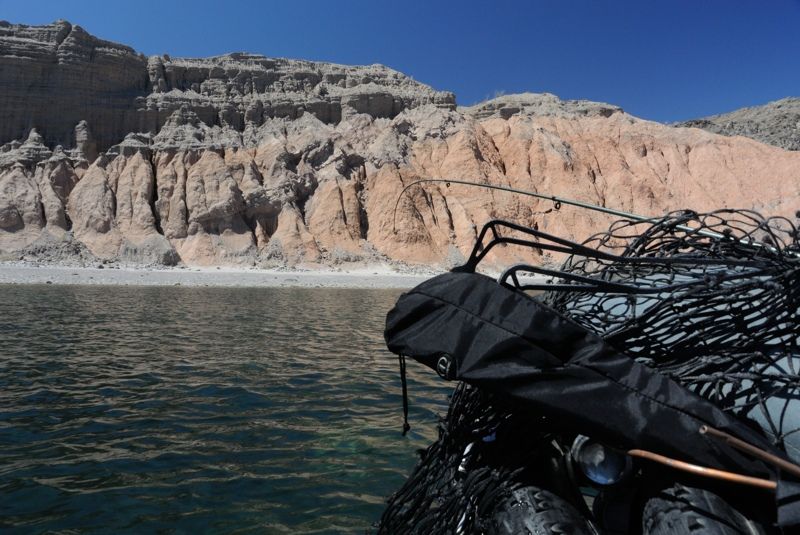
It was dead calm and really hot in my cramped and black little boat. But I just kept motoring along beside the desolate but dramatic cliffs. Some were
being used by hawks as nesting sites. There is nothing in the way of kelp beds along this section.

As long as you are moving though you'll get there so it didn't matter that I was slow. After about 7 km I hit the Spot GPS and noticed a bird boil. I
decided to race out to it. It was a half km offshore again. I got into the middle of the action, noted the fish scales in the water, remnants from the
undersea carnage, and casted with my 25 ft of line (I had shortened it to prevent jamming). This worked and I got one bite. This fish was quite a bit
larger than the barracuda so probably a yellowtail. It broke the line, or maybe my knot wasn't strong enough and it came off. I put another steel
leader and lure on but no more bites. Too bad.
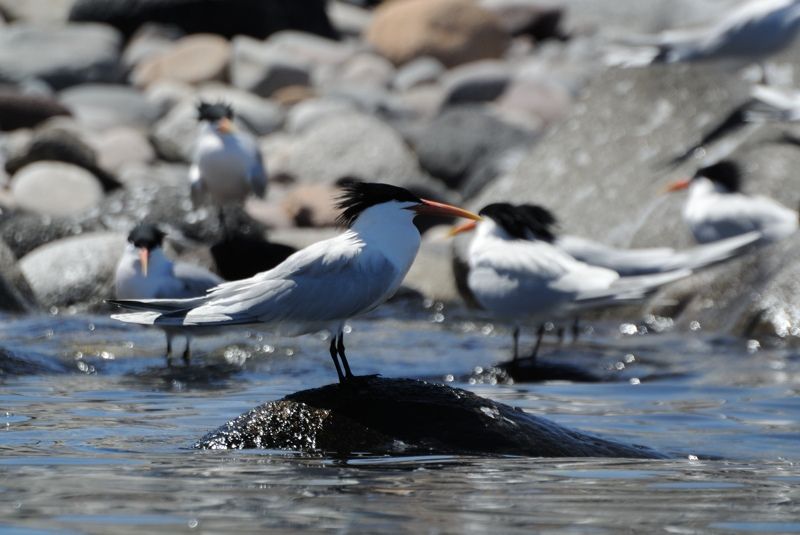
I returned closer to shore but kept trolling. Right around the corner was a nice sandy beach with a fish camp. It would be a good protected spot
during the northern gales.
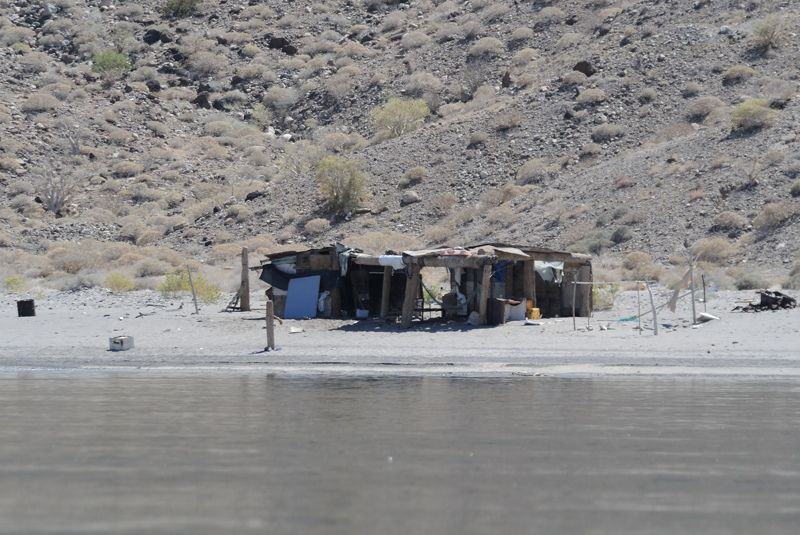
I contemplated stopping there but it was only a few more km to Candelero so I decided to go for it. I wasn't sure if I'd paddle all the way down to
Bahia Guadalupe or ride; based on the amount of seawater splashing on my bike, I'd probably ride as this is really not good for it.
I pulled in on a high but falling tide which was ideal since there were no barnacles on these high rocks and the falling tide ensured the boat
wouldn't re-float. But there were some decent waves from the north hitting this beach, with the fetch being the northern half of the Sea of Cortez.
The currents had shifted my direction as the tide started going out, and there was a slight tailwind. These were all perfect conditions for my paddle
that day.
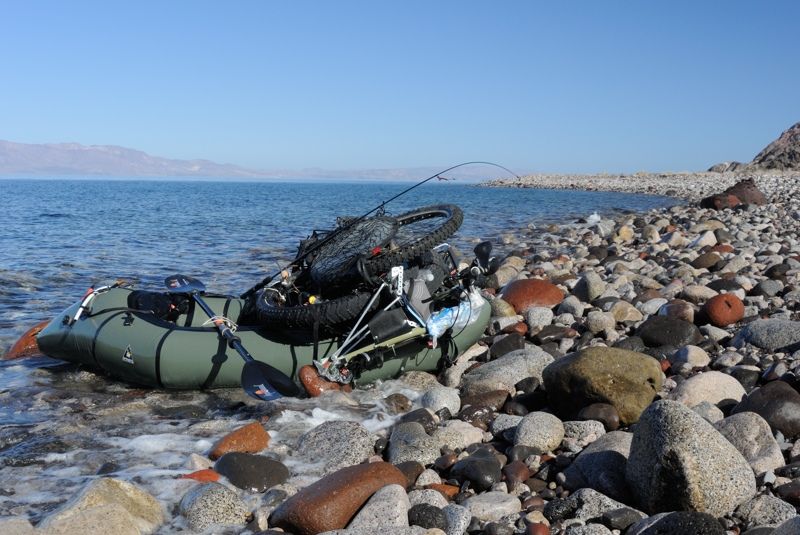
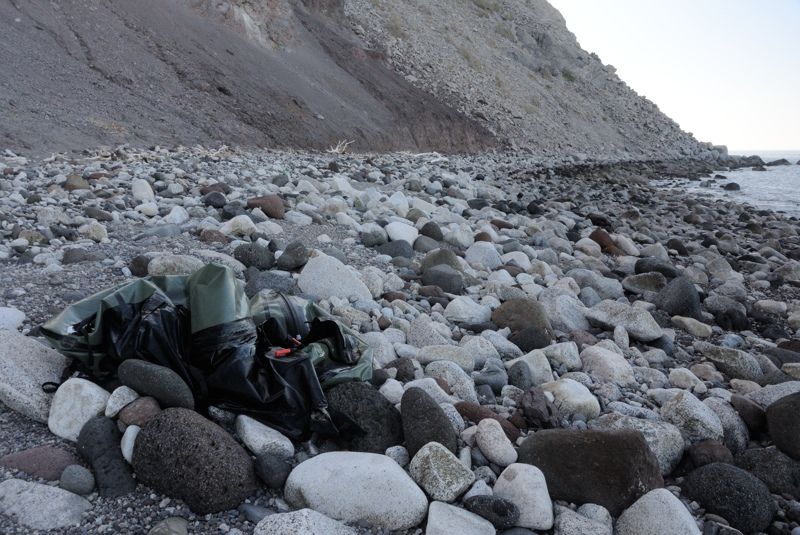
The sun soon went down behind the adjacent hill and immediately a dew covered everything since the winds were so calm. I pulled everything up to the
pebble area above high tide line and set up camp. There is a larger flat but dustier area a few feet higher that is the official campsite, accessed by
"road". There were tire tracks so I was definitely at the right place.
I immediately soaked the front brake in fresh water for half an hour, using the smelly stagnant water from the oasis. I used about 4 liters of water
that day, which was good considering all the sweating I was doing in my cramped boat in the blazing sun. I should be able to bring that down to less
than 3 sitting on the beach all day.
I was eating lots of energy bars, more than I budgeted for. I just couldn't help myself, I was so hungry. I had enchiladas for dinner. I was going to
spend the next day or two here desalinating enough water to get me back by land. I'd have to see how much I could desalinate per day.
As it got dark the crashing waves glowed green from phosphorescence, which is light released by planktonic algae when disturbed. It was a beautiful
scene. And I desalinated a liter of water that evening in the dark, and the phosphorescence was in the water I was filtering. They accumulated in the
prefilter of my backpacking filter so that would light up with green sparkles every time I pumped.
I had 8 liters of water in the morning. I wanted 4 days worth ideally, to get me across the desert by bike with enough extra to cover any unexpected
delays. That would be about 16 liters. So I had to desalinate 8 liters. But I also had to desalinate 3 liters per day just to stay even, so in reality
I needed to desalinate 14 liters if it took me 2 days. That was a lot of water. Sorry to bore you with all the details about my water production and
consumption statistics, but I want to record it for future reference, and it might be useful for someone else.
I set up the distiller pot and thankfully there was lots of wood on the beach. I also got going on the pumping. The pumping is boring and tiring. It
requires full attention and if you stop, you have to waste the first 2 minutes of new water after starting up again because salt diffuses across the
membrane if you don't maintain the pressure. So it requires full attention for about an hour to bang off a liter. And I prefiltered the water too to
prolong the RO membrane. And in order to save prefiltered water, I redirected the brine discharge line back into the seawater container being
desalinated. But this causes the water to get saltier and saltier as you desalinate it. So I could do that only until it used about a third of the
water, at which point it became too salty, and then I switched to a new bottle. So overall, I used 3 bottles of prefiltered water for every 1 bottle
of desalinated water I made. A lot of work. If I had some reading material the time would have gone by better but I didn't. Instead, I just lay there
in the heat of my tent and pumped, shifting positions every once in a while as my muscles tired.
Someone had recommended I go with the larger Survivor 30 unit, rather than the 06 model I was using which is intended more for emergency life raft
use. But it's three times heavier at 3 kg and a lot longer, making for more difficult transport on a bike. But in retrospect I should have gotten the
larger one as it's no fun spending half the day pumping. And an extra 2 kg isn't much when I'm typically hauling 15 liters anyways.
Then there was the distilling pot. This consists of a 2 liter stainless steel camping pot with a gasketed lid that clamps down and seals the top. In
the center of the lid I drilled a hole through which some brass fittings go to direct the steam out. These attach to a 5' long quarter inch flexible
copper pipe that feeds down to the bottom of my stainless water bottle sitting in a cold seawater bath somewhere down below the pot. Basically, as the
steam comes out it cools a bit as it goes through 5 feet of pipe, then bubbles through the previously condensed steam in the water bottle, and
collapses itself upon hitting the cooler water, adding more water to the bottle.
This works well when the fire gets going but it's not quite as fast as the hand pump. And it also allows you to do other things while it's working, as
long as you come back to tend the fire every few minutes. And it requires firewood, but it doesn't actually use that much since you don't need a huge
roaring fire. You don't actually want that; all you need is a consistent flame under the pot. So it's not like I denuded the beach of wood.
And it also allows you to cook food on the fire since you already have everything going; no stove needed. But it is a bit finicky and dirty, and hot.
And you have to add in the time it takes to get the water up to a boil, since when I boiled about half of it away it was time to start with a new
batch. One way to increase production would be to use two pots, with a smaller one that nests inside the larger one when packed up. This would
probably bring production rates up to that of the hand pump.
Overall, I can't say I prefer either method; it depends on my mood. The pump is cleaner but very boring. The distiller is more finicky but not as
mentally frustrating. It's good to have both though; the distiller pot is a good low-tech backup to the filter in case it fails.
In all I spent two days on the rocky Candelero beach desalinating water and getting my gear back together ready to ride up the wash. There were no
bird boils to go chase. At one point though a big pelican swooped in and landed 15 feet away to check me out. After 5 minutes he flew off. And one day
a scallop diving boat was poking around various places off the beach. On the evening of the last night a pair of coyotes visited camp. I heard the
empty water bottles by my tent moving and assumed it was a mouse. But then I turned to look out the beach and there was a dog standing 10 feet away! I
yelled and scared them off but they were back in 5 minutes. That was it, I got up with my light, grabbed the copper pipe, bashed the rocks with it and
chased them off, yelling really threateningly. That was enough, and I heard them later on in the night yipping off in the distance up the wash. No
biggy; I was in their terrain so obviously they're going to come check me out.
I decided I'd head back into town. It was too hard desalinating water and it didn't leave enough time to forage for food. Plus I was getting lonely.
It had been almost two weeks with no human interaction other than waving hello to fishermen. It's fun for the first week but then it gets lonely. The
question was, would I go back via Guadalupe, or just head straight back to the highway? Guadalupe could be nice, but is a bit of an unknown trail for
me. And I was really eating a lot of food so I didn't have as much as I originally thought. And when you're out there, it really hits home how
dependent you are on food and water. Without it, you're toast. It's easy to say, "well I'll just forage for food". But when you're just on the edge of
running out, it's a whole different mentality!
The winds had picked up too the last couple days. The waves get really big on this beach so I sure lucked out on the weather on my day of paddling.
This reconfirmed my decision to ride back. Without a bike on the boat it wouldn't be a problem to packraft south; and even with one it can handle the
waves. But my bike would have gotten soaked.
[Edited on 9-9-2014 by Mark_BC]
|
|
|
JohnMcfrog
Nomad
 
Posts: 156
Registered: 8-1-2012
Location: San Diego, Punta Abreojos
Member Is Offline
|
|
Mark,
You are the man! Love the details and the honesty.
John
|
|
|
Mark_BC
Nomad
 
Posts: 137
Registered: 12-1-2013
Location: Vancouver, BC
Member Is Offline
|
|
Part 10 - Back to Bay of LA
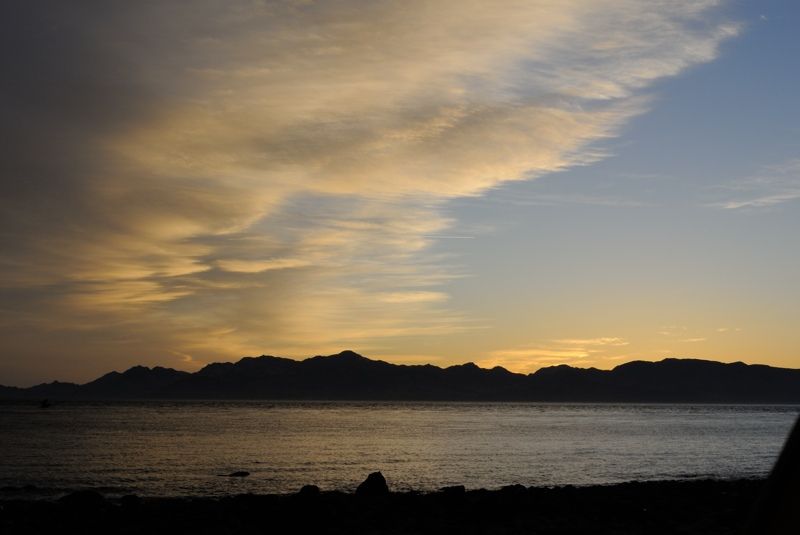


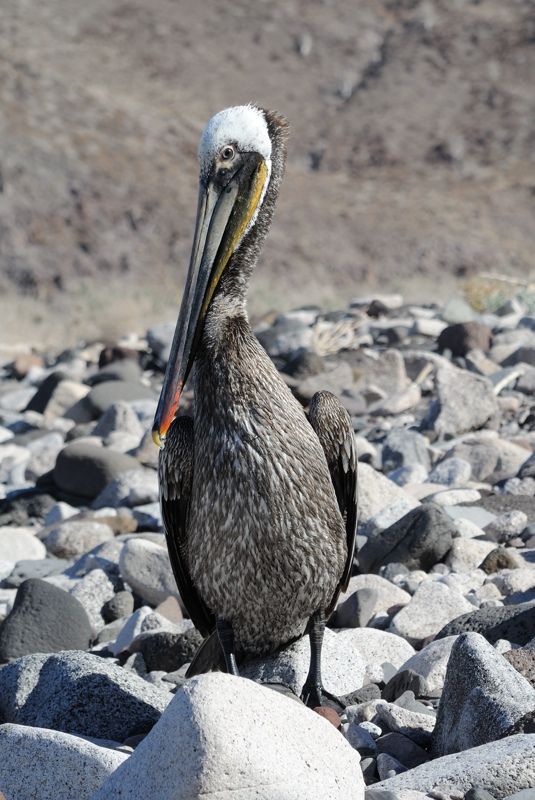
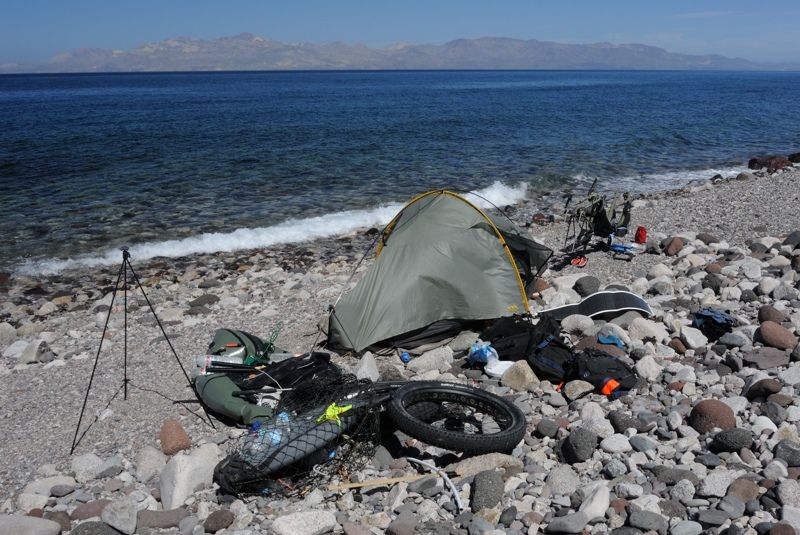
On the third morning of my stay at Candelero I had 12.5 liters of water. Conservatively, that would give me 3 days to get back to town, or
alternatively "safety", being the highway where I could flag drivers down for water. So I thought that was good enough.
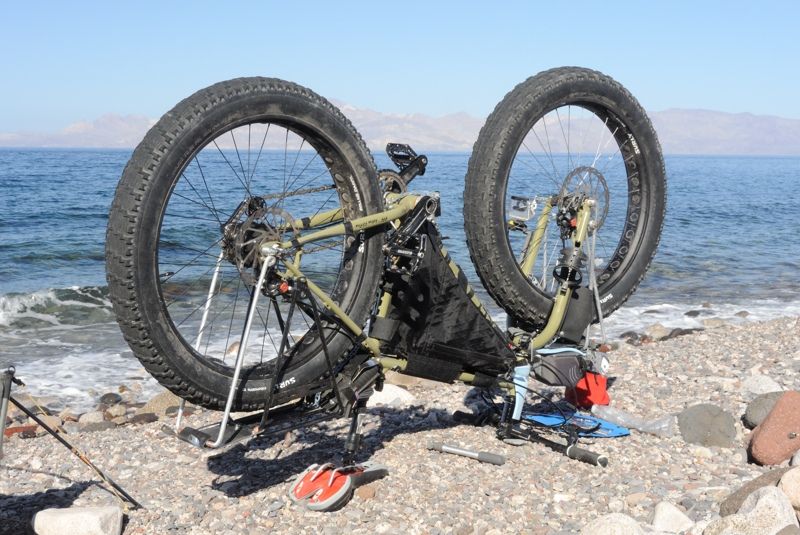
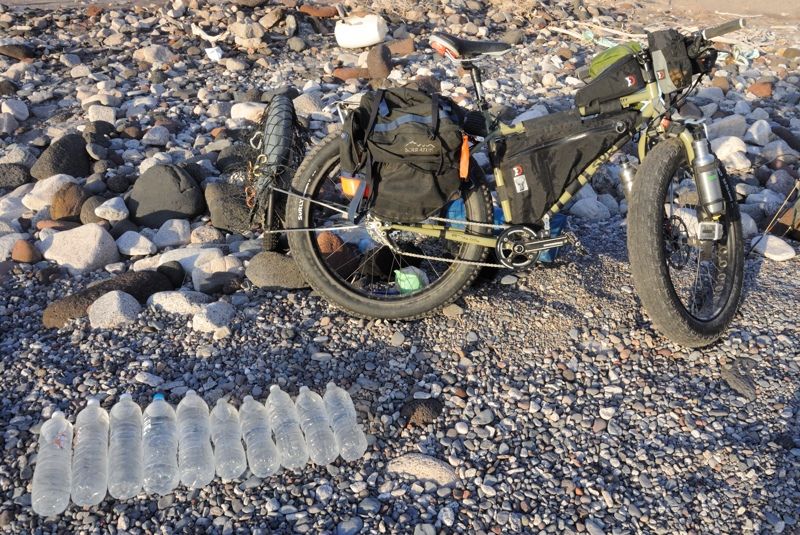
I got up before sunrise and headed out early, by 9. I soon went by some smaller versions of the pink hills. Then I was in a little bit of shade beside
the big hills which was nice.
It wasn't long before I got to the tight double 180 degree turn in the canyon. It looks pretty intimidating on GE but it's all nice and sandy, no
rocks.
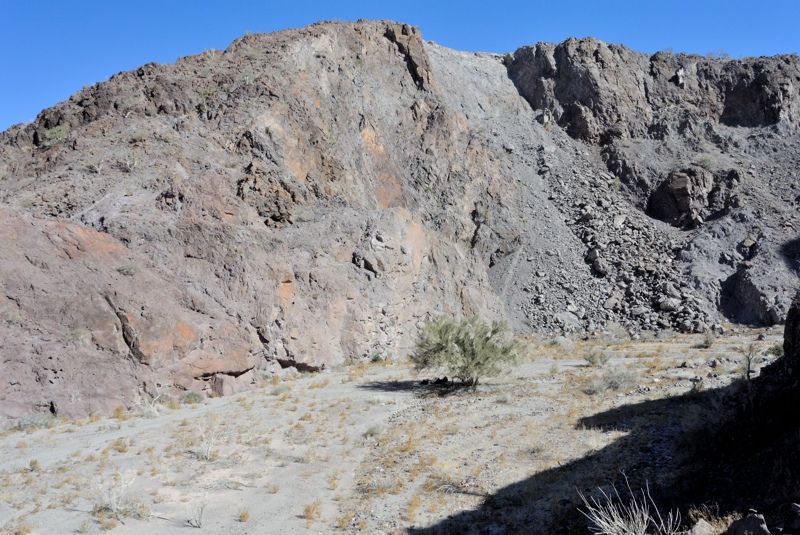
And speaking of sand, I was concerned that the road would get increasingly sandy and difficult to ride as I went up the wash and the terrain turned
into sandy lakebed. So far, it was gravelly, and I wasn't even on the "road" most if the time, instead just picking my way through the wash channels.
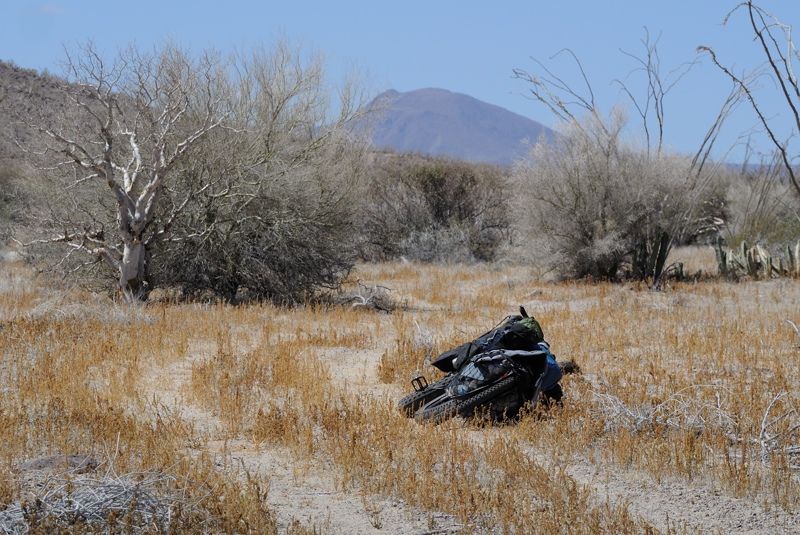
The canyon widened as I went up and got pretty warm. I took a lunch of peanut butter on energy bars and dates and hit the Spot GPS. The road continued
on up and yes it was getting more and more sandy, and more difficult to ride. And there was washboard too, which I am learning to hate with a passion.
I think that should be someone's PhD research paper -- how washboard forms and how to prevent it. Maybe someone's already looked into it. So I
actually rode up the sand adjacent to the road.
And I think I figured out why some sand is firm and some is loose and difficult to ride. It doesn't have to do with age, it has to do with
disturbance. After a rain, as the sand dries it draws salts up to the surface. These form a crust when they finally do dry that creates strength to
the sand. As soon as something breaks this, the sand becomes loose. That would be quad tracks, 4x4 tracks, or animals. That's why the sand in the
middle Salsipuedes was loose, because there was lots of little animal activity churning it up. On that larger tributary wash further up it was drier
with no groundwater and didn't support as many animals. At least that's my theory.
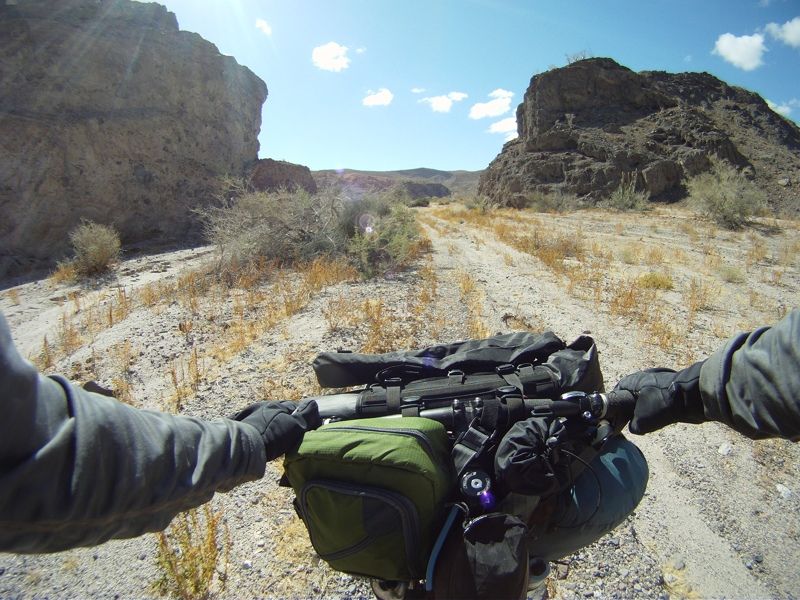
At one point I went up the wrong tributary wash but figured it out pretty fast and got back on track. I kept going up and knew that at some point I'd
crest and start going down into the big dry lakebed. My goal for the night was the staging area I've camped at a few times. But that road just kept
going up and up. Eventually it finally crested, around where I could have turned left to try that overland route up and over the other wash leading
into Guadalupe. But the ground was a bit rocky and spiny and looked difficult. And I didn't have much goop left in the front tire. Plus I didn't have
a lot of food or water so I decided to skip it and maybe try again sometime when better provisioned. You gotta leave something for next time!
So I started coasting down into the lakebed and went over a spiny branch and the front tire started hissing. It was barely lunchtime and I was hoping
it would last until the campsite where I could take everything apart and fix it. But no, this one went down fast. Only 1.5 km from my campsite, it
died and I had to fix it there.
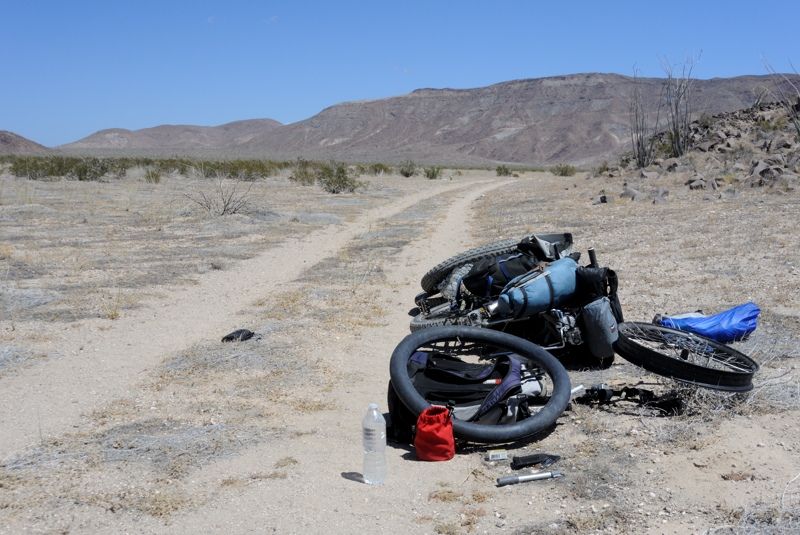
I took the front tire off and checked for spines. I found them, pulled them out, cleaned up the tire, and tried to get the tire goop to seal up the
hole in the innertube. But it wasn't working; maybe the hole was too big, or I'd had so many holes that the goop was loosing its rubber ingredients
and effectiveness. All it was doing was squirting goop on the ground so I basically had none left. But I did have a few cc's collected in the tire...
So I got out an old film canister I was putting fishing lures in and scooped it out. The syringe needed to inject the goop in the tube was buried over
at the detour down Guadalupe that I'd be passing the next day. So I had to put a few patches on the innertube. No big deal, just like a regular tire
flat.
I managed to get on the road again and pulled into camp early afternoon. I was hoping to mount the Gopro to the trailer, something I hadn't had time
for previously. The issue is that it really vibrates back there. So I solved that with my specialized mounting technique of wrapping the hell out if
it with the stringy packing tape I had brought for packing up the bike boxes...
I think it worked, but I won't know until I review the video later. It's a good mount position if you can get it to stop vibrating.
Other than that I just relaxed and organized. Hummingbirds came by, attracted to all the flourescent pink and orange on the reflectors and zippers.
It's not really so desolate out there. The wind was pretty strong from the north so I chose a sheltered spot behind some rocks, up against the hill. I
looked up and noticed some precarious rocks on the talus slope ready to fall down on me. I'd have no chance if one rolled down. But then I reasoned
that they've been up there for what, like a million years? And there were basically none in the sandy lakebed where I was. So the chances were pretty
slim.

That night was still and very cold. I was sure it would freeze and my water would turn to ice but it didn't seem to. And I managed to escape death by
falling rocks. I guess I still have 7 lives left.
I was going to try to get over to near the highway that day and camp there. No point in getting into town in the evening. That destination shouldn't
be too difficult over the mostly flat road.
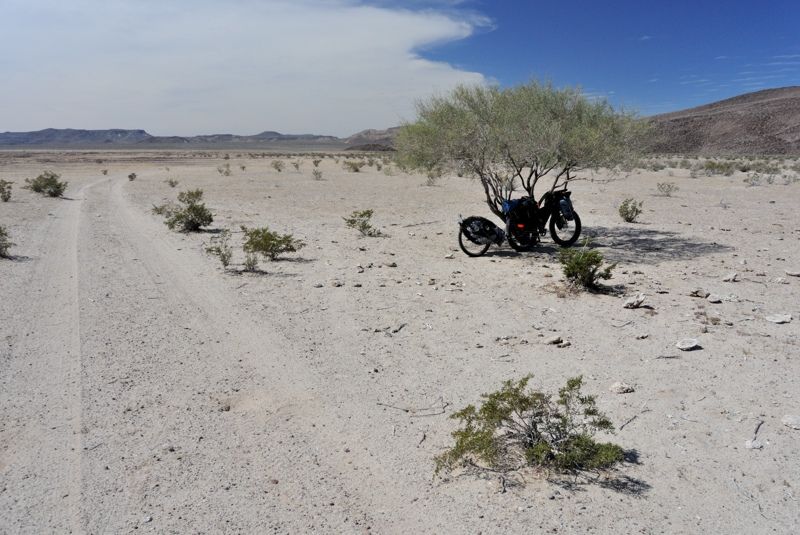
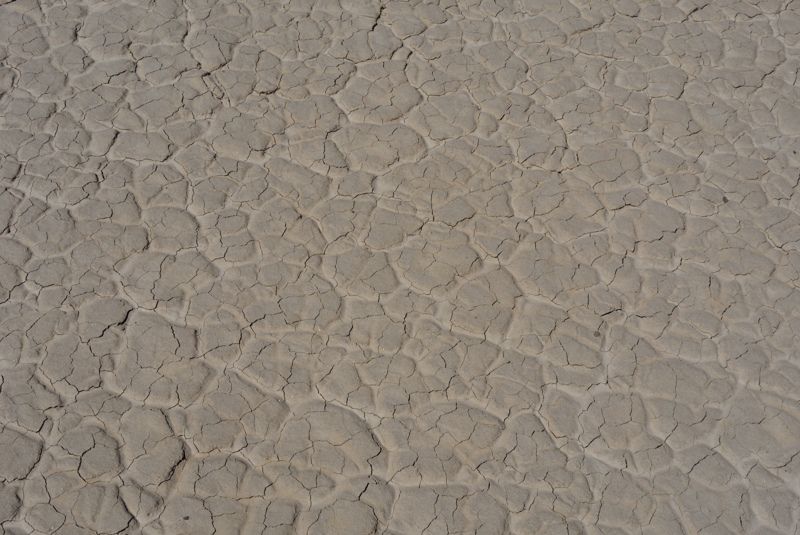
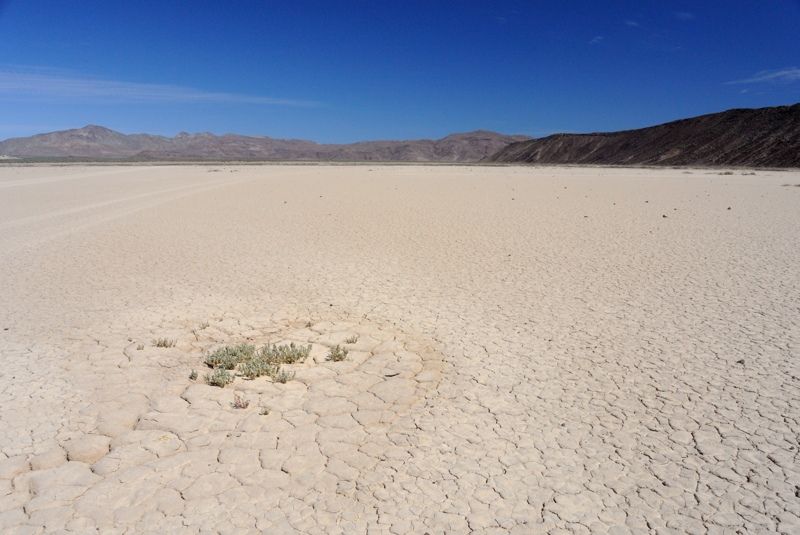
I went by that rock cairn in the second lakebed. I'm not sure what it says, I think it marks where someone died. I'll get my Mexican friend to
translate for me.
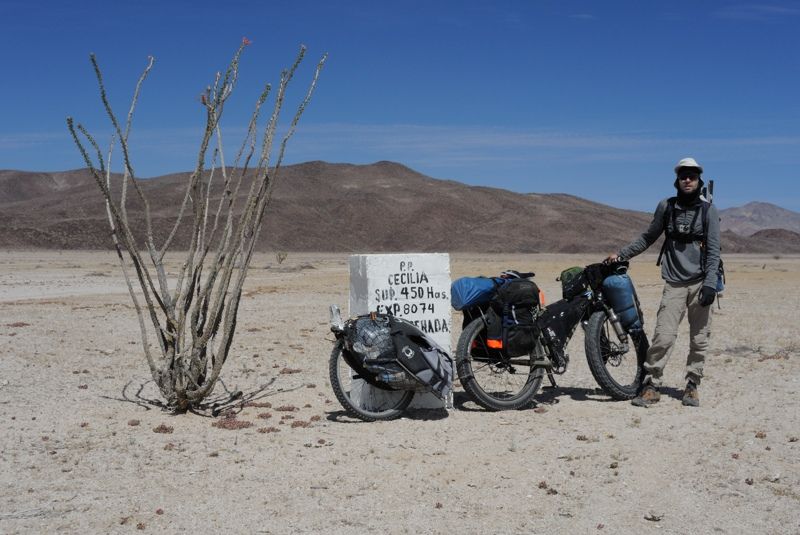


At the junction to Guadalupe I dug up my stash exactly as I had left it, and right around there I noted the motorbike track heading west away over to
the Yubay area. I'd like to ride that on my bike someday.

I climbed the hill between the two lakes which was more work than expected in the midday heat and headwinds. Finally I summitted and descended the
rocky road leading down into the first lakebed. It seemed to go on longer than I remember in a car! That probably had a lot to do with the increasing
headwind.
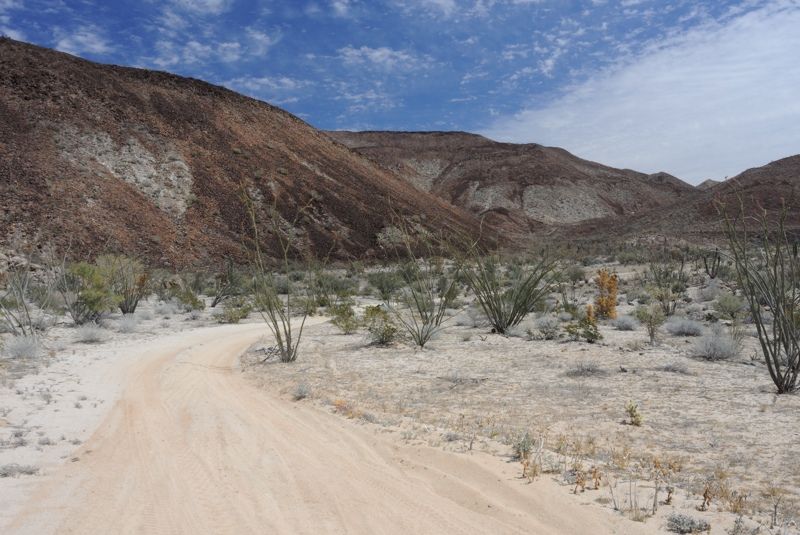
I had lunch under the shade of another tree. It's good that there are trees out here every once in a while. I dropped a date in the sand. I guess some
mouse was going to hit the jackpot that night. Then I was back on the road in the heat.
Then two dune buggies came up behind me -- Americans staying in Bay of LA that had been all over. We chatted for a while and then they were off again
in a cloud of dust.
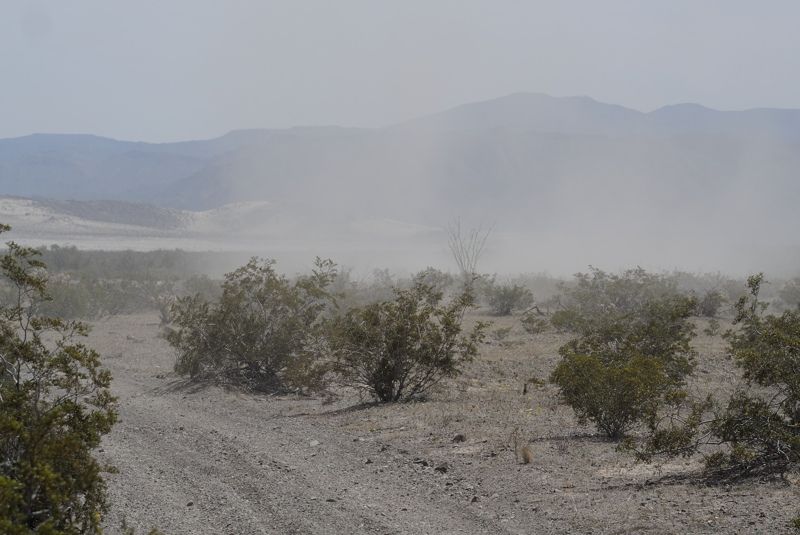
The dust wasn't just from the buggies though, it was actually from the wind, strong enough to be creating dust devils and whipping salt up off the
lakebed. And I'd have to ride through that.
The headwinds got stronger and stronger as I made my way across the salt bed. It was brutal, but I just told myself what I always do -- if you just
keep moving you'll eventually get there.
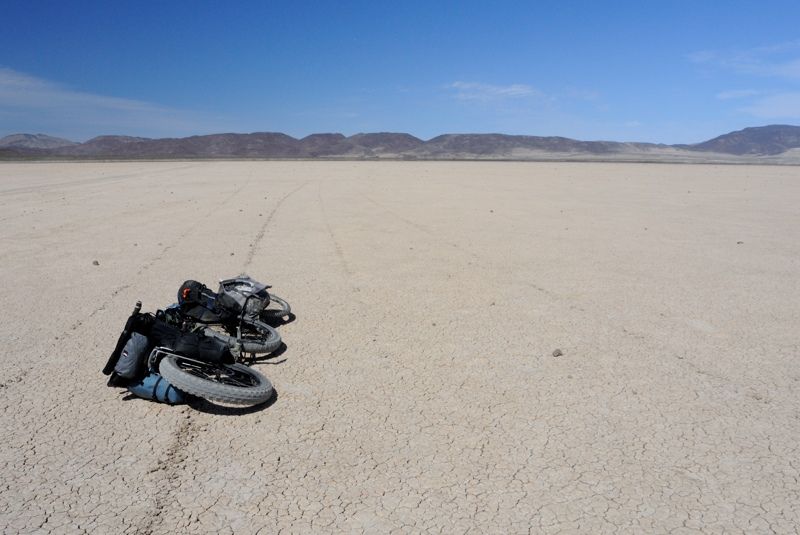
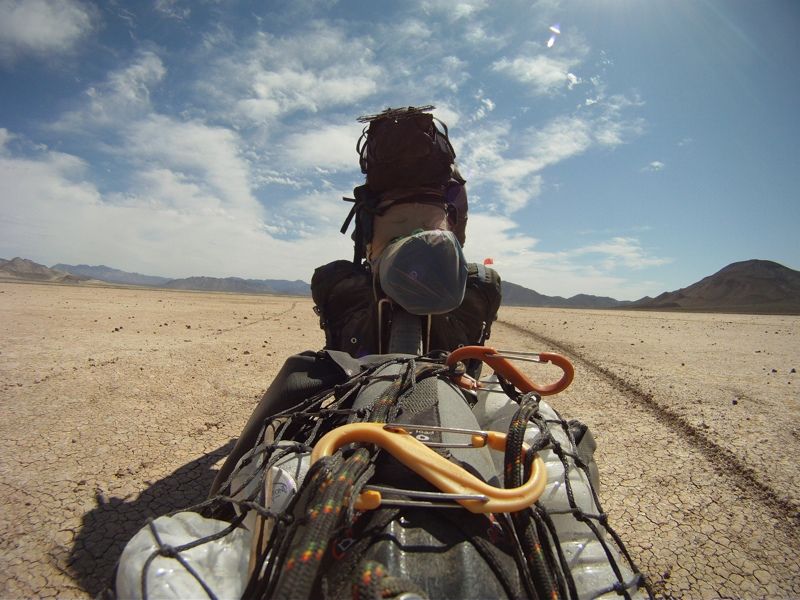
I finally did and instead of going to the highway I turned left and headed for the tower and the well water pump station for town. At least then I was
only in crosswinds.
I was totally drained and when I got there the pump was too noisy to camp. I plodded on another km or so and took shelter behind a creosote bush and
set up camp. The winds didn't seem to be dying.
I basically just made dinner and went to bed. It was nice to be back in civilization again; I hadn't spoken to anyone in 2 weeks. And the desert was
in bloom here with fields of pink, white and yellow flowers. It was really beautiful and the smells of the flowers helped take the edge off a brutal
day and exhausted body.
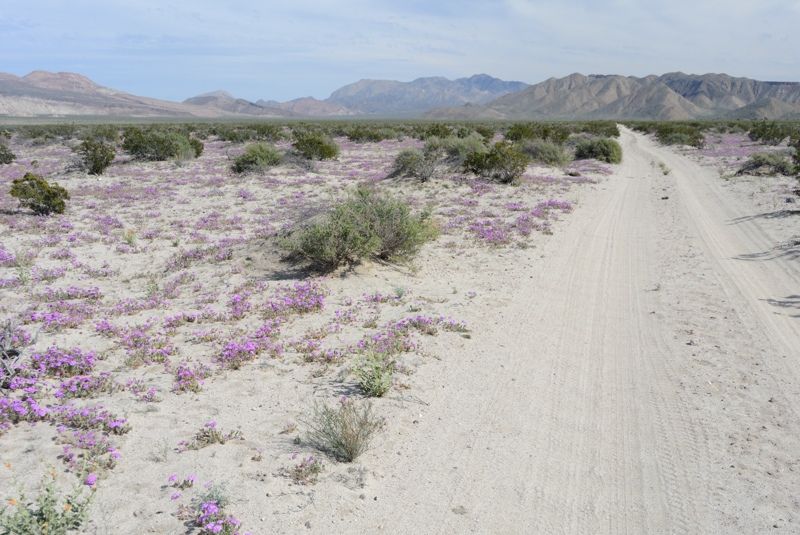
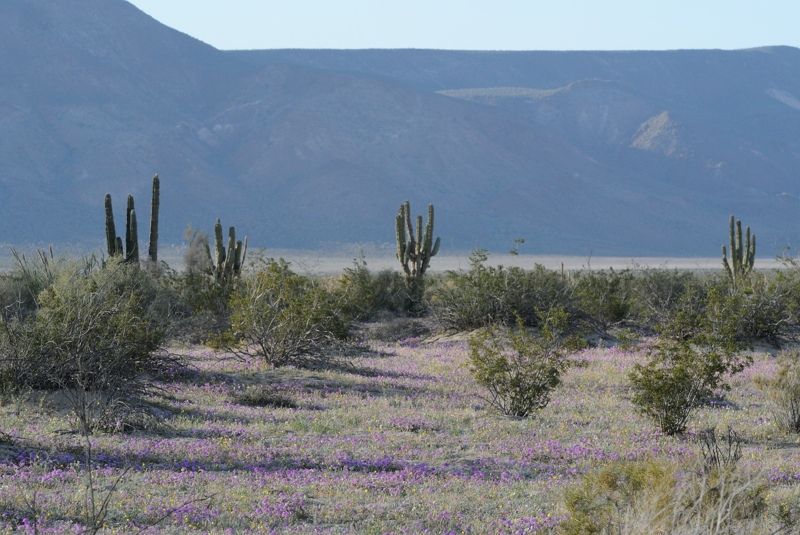
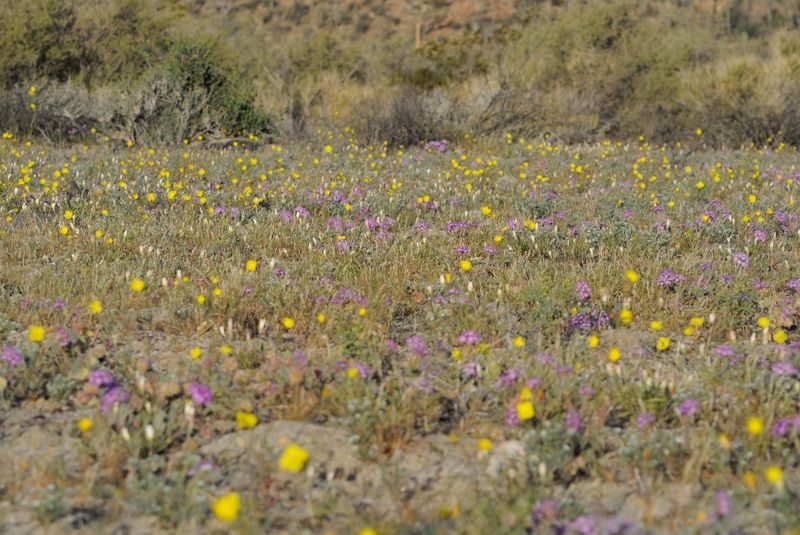
Salt caked on the spoke nipples. I'd have to wash that off sometime soon.
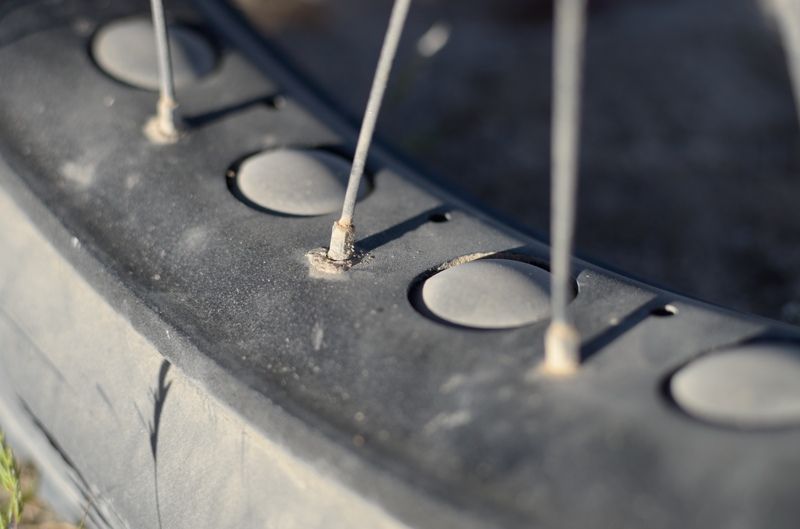
The wind kept up all night and I packed up fast the next morning; I think I was out by 8. I had 4.5 liters of water that morning, meaning I used 4 per
day to get there; that's pretty good considering how hard I worked. I estimated that well, with a bit of spare capacity in case something went wrong.
So my math paid off!
This day promised to be totally different than the previous. The headwinds were now tailwinds! I pumped up the tires and flew down that highway!
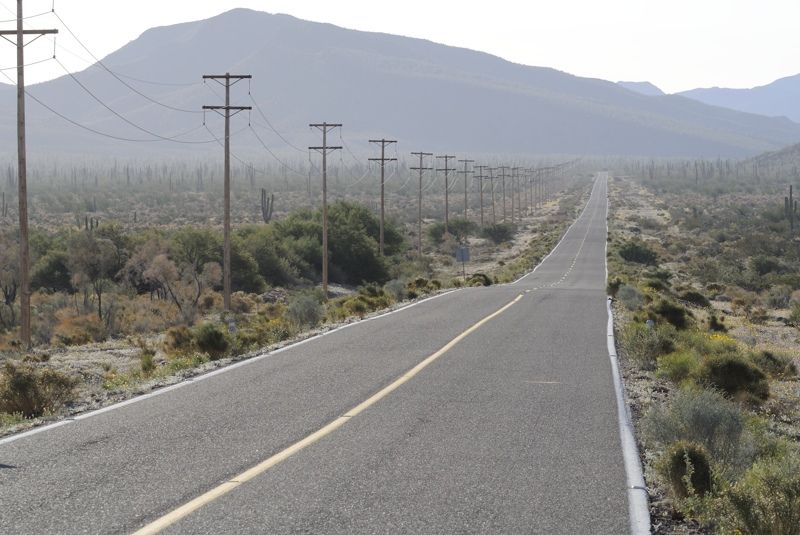
It wasn't hard getting to the summit and after that it was all downhill. I didn't pedal, and couldn't pedal, since my gearing didn't go that high. I
intentionally built the bike with low gearing to help with grinding through tough terrain and to limit myself from going too fast. But with that slope
and tailwind I didn't need gearing! I was probably doing 50 or 60 km/hr and made it into town by 9:30.
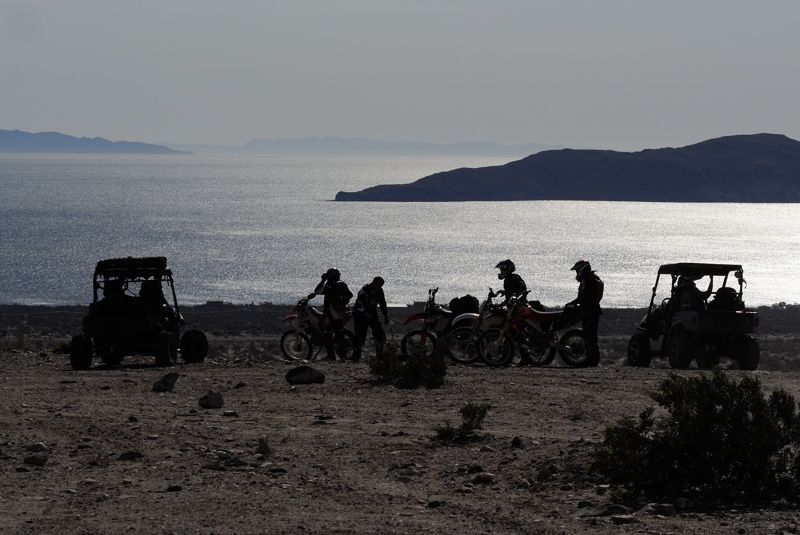
I felt like half the day had gone by but the town was just opening up. I immediately stopped at China's taco stand which wasn't open yet, and went on
the internet. I loaded up with food from the store and rode north of town to check in for camping at Daggett's. The rest is history...
I had 2 weeks before Mark and Morgan and everyone else was going to come down with their 4x4's to go spearfishing at Guadalupe and across at Isla
Angel de la Guardia. I was going to meet them on the beach at Guadalupe, getting over via the motorbike track from la Gringa. In the meantime, I'd
recuperate and write the trip report which, if you're reading this, I apparently have done, except for the chapters yet to come at Guadalupe with my
friends!
[Edited on 9-9-2014 by Mark_BC]
[Edited on 5-2-2016 by Mark_BC]
|
|
|
David K
Honored Nomad
        
Posts: 65361
Registered: 8-30-2002
Location: San Diego County
Member Is Offline
Mood: Have Baja Fever
|
|
You prove that Baja is the land of adventure! Thank you Mark!
|
|
|
Barry A.
Select Nomad
      
Posts: 10007
Registered: 11-30-2003
Location: Redding, Northern CA
Member Is Offline
Mood: optimistic
|
|
Part 10 was a good as the rest---------well done, Marc. I thouroughly enjoyed it, despite the vicariousness of it all. You have given the best
report on this area I have seen since ESG escapades with his friends outlined in his book.
Barry
|
|
|
woody with a view
PITA Nomad
      
Posts: 15940
Registered: 11-8-2004
Location: Looking at the Coronado Islands
Member Is Offline
Mood: Everchangin'
|
|
standing-by for the next chapter(s)......
|
|
|
Skipjack Joe
Elite Nomad
     
Posts: 8088
Registered: 7-12-2004
Location: Bahia Asuncion
Member Is Offline
|
|
Thank you Mark. This was a most excellent read.
|
|
|
| Pages:
1
..
18
19
20
21
22
..
25 |
|

